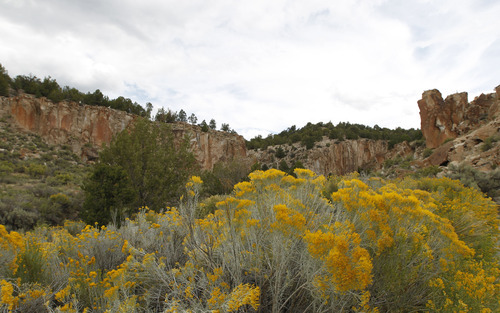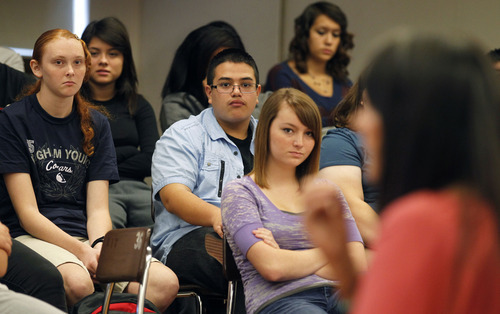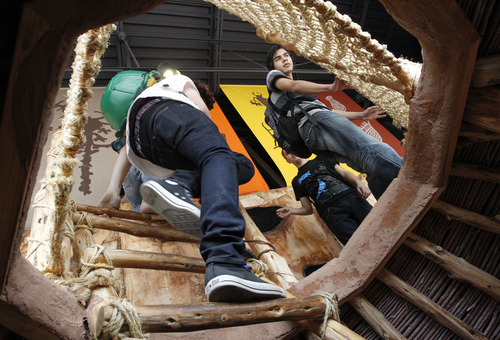This is an archived article that was published on sltrib.com in 2012, and information in the article may be outdated. It is provided only for personal research purposes and may not be reprinted.
Richfield • Native-American storyteller Dovie Thomason stood beside an iron gate separating her from a cave filled with ancient treasure. At the Cave of a Hundred Hands in Fremont Indian State Park, she reached her own hand through the bars and compared it to a slender-fingered print so similar she realized it could be hers.
"There were human beings here," said Thomason, who accompanied a group of Granger High students from West Valley City to the site earlier this month.
The renowned storyteller described her experience at the cave as humbling, and said she could almost feel the gratitude emanating from people who lived a 1,000 years ago in the harsh red landscape of southern Utah.
Thomason and muralist Lee Madrid, along with other artists and educators at Granger High and the Center for Documentary Expression and Art, want to remove the iron gates that keep 21st-century students from learning about their ancient Utah neighbors.
In order to do that, they are embarking on a four-part, monthlong art immersion project that takes students back in time to meet and understand the ancient Native American people who inhabited the state years ago.
The project entails a trip to see rock art and observe the art of weaving stories with Thomason. Students will apply what they learn by creating their own "Sacred Images" mural, with the assistance of Madrid, which will be housed in the nearly completed new Granger High building, set to host up to 2,400 students.
"Lee is the visual part of the story. I'm the spoken word," said Thomason as she told her stories to students. "Together we bring this ancient, ancient thing to you in a 21st-century style."
Thomason asked the students what images mattered to them, what they would want their great-grandchildren to see on their mural and whether or not their ancestors would understand their sacred images.
The goal of the project, organizers say, is that students will be introduced to the humanity and culture of an ancient people, but they also will find new discoveries within themselves along the way.
—
Mysterious rock art • "Doesn't it blow you away?" said art teacher Andrea Heidinger during a recent field trip with students as she approached the first rock art samplings at Fremont park out of 3,700 ancient images that are there.
Heidinger, along with artist and historian David Sucec, explained to students that the meaning of the art is largely unknown.
"A lot of times images are not representations of things, they just use that representation to say something else," said Sucec. "Sometimes if you see a line of sheep going in one direction they're not necessarily talking to you about sheep, they're talking to you about a line of travel."
The historians and artists that Sucec works with don't spend a lot of time arguing about meaning because there's no way to discover who's wrong and who's right, he said.
"You don't know what it means," Heidinger said, but "we can appreciate that they were trying to express something visually, and now these kids in terms of their artwork, they want to express something visually, too."
Thomason emphasized to students how rare the ancient artwork is.
"On the planet there are few places as rich in this sort of art or this sort of narrative as Utah," she said. "I think [the art reminds] us that we're part of something very old."
—
The need for stories • Ever since Thomason was a child and her grandmother instilled in her a love for stories, she has been searching for tales to tell. She knows about 700 stories — including one with origins she believes extends back to 18,000 years ago.
Thirty years ago she left her job as a college professor and became a full-time storyteller because she wanted to know whether or not the world still needed the lessons that stories taught.
After 30 years, she's convinced that it does.
"We're hard-wired this way. This is who people are," she said. "People are the animals that ask why."
When Thomason tells stories she does not plan in advance which stories she's going to tell. She just talks, and depending on her mood, the mood of the audience, the weather, the news, whatever the circumstances, the right story will just come to her.
"The stories choose themselves," she said.
During a recent visit to Granger High, Thomason related her stories to the lives of the teenagers she was speaking to.
She told a story about a man who is both man and spider. He's known as a spider because he traded his good mind for a handsome face. Now the only time he feels clever is when he's tricking people.
"Maybe you've met him," she said as the students laughed. "I'm sure he goes to this school. I see him everywhere: in the halls, in the malls, he's all over the place."
She called him the "original Spiderman" (minus the silly suit).
After students had listened, engrossed in her narrative, Thomason ruminated on the importance of storytelling. Stories are so vital, she said, because they're relatable to people's lives and they provide powerful images.
"We live by our stories, whether we know it or not," she said. "So if we aren't mindful about choosing our images, choosing our stories, we'll just go to the default of what the world is throwing at us, and it has a lot to do with [being] thin and a lot to do with a lot of other things."
—
Creating a sacred image • The Center for Documentary Expression and Art has completed the project under way with Granger High students at different schools throughout Utah, but this is the first time the group has worked with the Granite School District.
People are overwhelmed when they see the murals that students create after participating in the program, said Madrid, who facilitates the murals.
"You're creating your sacred image to last a long time," he said.
That is an aspect that Granger High art club president Jason Nguyen finds appealing about the project.
"We can go above and beyond," he said. "Not just do little assignments our teachers give us."
Nguyen said the program allows students to reach outside the community they live in and explore different cultural perspectives.
Madrid said it's inspiring to see students find a sense of accomplishment once they've created a mural. And Thomason said working with students who are crafting their identities is an invigorating part of helping them during the creative process.
"They're really starting to articulate the questions they'll be working on the rest of their lives," she said.
She said whether it's 2012 A.D. or 400 A.D., people have always had stories and they have always had art. They've used both to attempt to illustrate who they are.
"We haven't changed so much than those people who were putting their hands on the walls in the canyons," Thomason said. "We haven't changed that much."
At a glance
The Center for Documentary Expression and Art's "Sacred Images: Artists-in Residence" program is a month-long, four-part program designed for intermediate, high school and college students.
Part 1 >> Placement of the award-winning Sacred Images exhibit at a participating school and description of Utah's four major Utah rock art styles, provided by David Sucec, rock art historian.
Part 2 >> Field trip to a local rock art site guided by David Sucec, rock art historian.
Part 3 >> Storytelling and discussions led by Dovie Thomason, a nationally recognized Native American storyteller.
Part 4 >> Mural painting with Lee Madrid or Ruby Chacón, Utah artists, who help participating students translate their project and personal experiences onto a mural-sized canvas.
Source: cdeautah.org



















